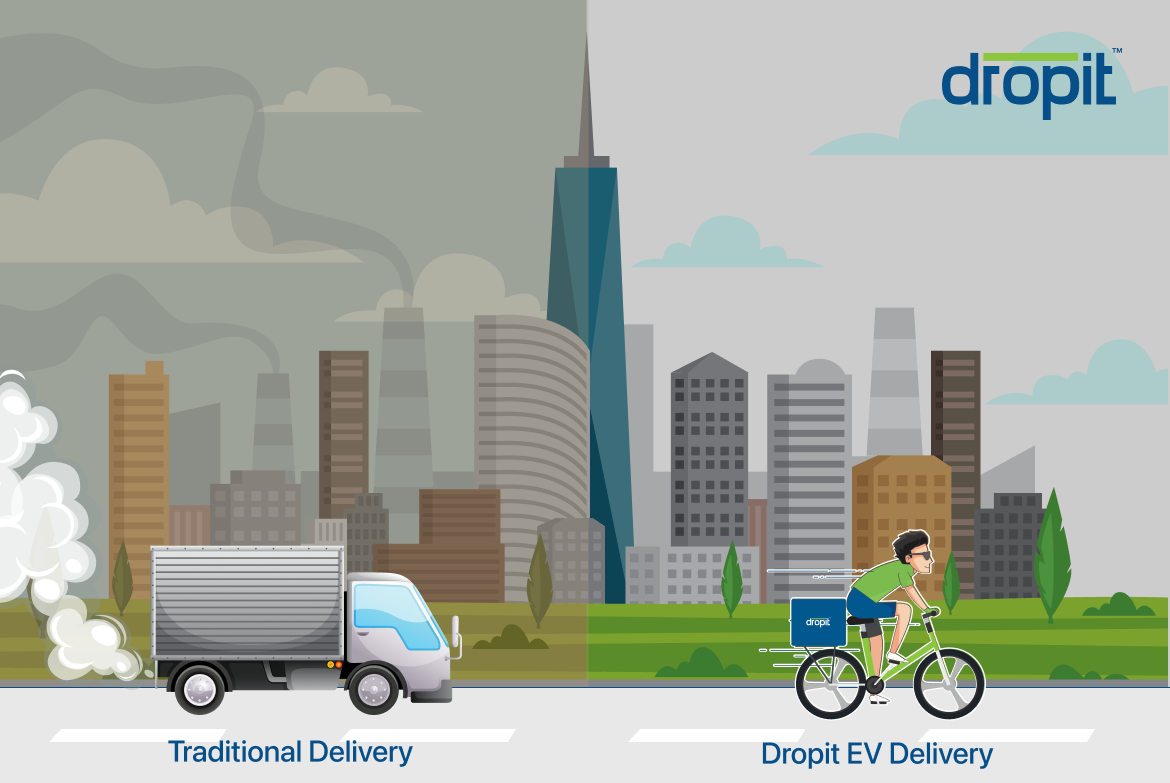In the race to make cities cleaner and supply chains more sustainable, logistics is under the microscope. Last-mile delivery, the final step from retailer to customer, is often the most polluting and inefficient part of the process. But there’s a new model gaining traction: green logistics powered by EV cycles.
Dropit is leading this change, using electric cargo cycles to transform how products move across cities. The results? Fewer emissions, less traffic, cleaner air and a scalable solution for urban commerce.
This blog dives into the environmental impact of Dropit’s EV cycle deliveries, and why they represent the future of sustainable last-mile logistics.
1. Why Last-Mile Delivery Needs a Rethink
Last-mile delivery makes up just a fraction of the overall logistics chain, but it’s responsible for over 50% of total delivery emissions in urban areas.
Traditional delivery vehicles:
- Rely on fossil fuels
- Contribute to traffic congestion
- Emit CO₂, NOx, and particulate matter
- Struggle in narrow or pedestrian-heavy zones
As urban populations and eCommerce orders rise, this problem gets worse unless cities adopt more sustainable last-mile strategies.
2. The Dropit EV Cycle Model
Dropit replaces vans and scooters with electric cargo bikes (EV cycles) operated by trained local delivery partners, often youth from the surrounding area. These bikes are:
- Powered by rechargeable lithium-ion batteries
- Designed for city terrain and narrow lanes
- Capable of carrying 40–100 kg payloads
- Fast, quiet, and emission-free
By building bike-first logistics routes, Dropit lowers the carbon footprint of each delivery without sacrificing speed or reliability.
3. Measuring the Environmental Savings
Let’s break down the numbers:
| Mode of Delivery | CO₂ Emissions per KM | Noise Pollution | Urban Impact |
| Diesel Van | ~271g | High | High congestion |
| Petrol Scooter | ~72g | Medium | Moderate |
| EV Cargo Cycle | ~0g | Near-zero | Low |
Each EV cycle delivery avoids approximately 1.5 to 2 kg of CO₂ compared to a standard vehicle delivery and that adds up fast across thousands of orders.
4. Cleaner Air in High-Density Zones
Dropit strategically uses EV cycles in areas with:
- Dense populations
- High foot traffic
- Restricted vehicle access
- Pollution-control zones
In these zones, conventional delivery vehicles either aren’t allowed or worsen congestion and air quality. EV cycles glide through efficiently, improving the delivery experience without harming the urban environment.
5. Noise Pollution Reduction
EV cycles are virtually silent, which makes them ideal for:
- Early morning or late-night deliveries
- School or hospital zones
- Residential neighborhoods
This reduces noise complaints and improves city livability, a key factor for municipalities considering sustainable transport solutions.
6. Energy Efficiency That Scales
Electric cargo bikes consume a fraction of the energy of electric vans. One fully charged e-bike battery can support up to 60 kilometers of delivery range using about 0.5 kWh.
To put that in perspective:
- A single EV van trip may consume 6–8 kWh
- A diesel van burns ~1 liter of fuel per 10 km
With Dropit’s model, cities can scale delivery infrastructure without scaling energy demand.
7. Supporting Circular Logistics
Dropit’s EV cycle model isn’t just for forward deliveries it also supports:
- Pickup of returns
- Packaging collection for reuse
- Reverse logistics for retail partners
This means Dropit can reduce waste on both ends of the transaction, contributing to a more circular and sustainable supply chain.
8. Empowering Green Jobs for Youth
Dropit’s delivery partners are often young local riders, trained and equipped with EV cycles. This promotes:
- Green job creation
- Local economic participation
- Eco-conscious career opportunities
This model creates a socially sustainable workforce alongside its environmental impact making Dropit’s green delivery strategy even more holistic.
9. Minimal Infrastructure Footprint
Unlike delivery vans that require:
- Parking bays
- Loading zones
- Fueling infrastructure
EV cycles can operate with minimal infrastructure:
- Small charging stations
- Compact bike storage
- Mobile service kits
This makes them ideal for urban environments where space is limited and mobility is key.
10. Aligning with Global Green Goals
Dropit’s EV delivery model supports broader sustainability efforts, including:
- United Nations’ Sustainable Development Goals (SDGs)
- Local clean air initiatives
- Corporate ESG targets for retail partners
Retailers using Dropit can showcase their contribution to Scope 3 emissions reduction, enhancing their brand reputation and compliance reporting.
Conclusion: A Cleaner Delivery Future on Two Wheels
Logistics doesn’t have to come at the planet’s expense. Dropit proves that with the right tools and the right mindset delivery can be fast, scalable, and environmentally responsible.
Electric cargo cycles represent a turning point in urban logistics. They reduce emissions, improve air quality, and offer a practical solution to the last-mile problem. Dropit’s model not only delivers parcels but also delivers on a promise: to move smarter, cleaner, and more consciously.
With the Dropit App, customers and businesses can schedule pickups, track deliveries in real time, and choose a greener delivery option with just a few taps. It’s convenience meets conscience, on-demand.
Ready to make your deliveries greener?
Partner with Dropit and switch to an EV-powered last-mile model that drives real environmental impact.
